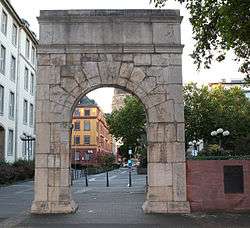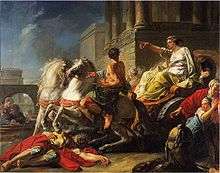Landesmuseum Mainz



The Landesmuseum Mainz, or Mainz State Museum, is a museum of art and history in Mainz, Germany. In March 2010 it reopened in full after an extensive renovation.[1]
The museum has its roots in a painting collection donated by Napoleon and Chaptal to the city of Mainz in 1803. It moved into its current location, in the former electoral stables, in 1937, by which time it had grown significantly. It received its present name in 1986, and was renovated and modernised from 2004 to 2010.[2][3]
Collections
(Partial list.)[4]
Pre-Historic and Roman Departments
Antiquities from the Mainz area, including a Venus-like statue from 23,000 BC; stone axes from the Late Stone Age; Roman stone memorials; busts of bronze and marble; a 1st-century Roman Jupiter Column; a 3rd-century Roman arch.
Prince Johann Georg Collection
Near-Eastern finds assembled by Prince Johann Georg, including medieval icons, Byzantine art and Egyptian relics.
Medieval Department
A Byzantine spangenhelm; a Madonna made of ivory; a relief cycle of Prince Electors; a cycle of nine paintings of Mary by the Master of the Housebook.
Renaissance Department
Works by Lorenzo di Credi, Hans Baldung Grien (presumed),[5] Peter Binoit (presumed), Philippe de Champaigne,[6] Willem Claeszoon Heda, and Jean Bardin.
Baroque Collection
17th- and 18th-century paintings, sculptures, furniture and porcelain from Germany, France, the Netherlands and Italy; a set of equipment belonging to Maximilian von Welsch.
19th- and 20th-century Paintings
Works by Philipp Veit, Wilhelm Lindenschmit the Elder, Max Liebermann, Lovis Corinth, Antoni Tàpies, and one painting by Pablo Picasso (Head of a Woman).[7] The large collection of Max Slevogt paintings is mostly displayed in Villa Ludwigshöhe.[5][8]
Graphics Collection
Works by Edgar Degas, Paul Signac, Alfred Sisley, Picasso, William Turner (Mainz from the South, watercolour),[5] Adolph von Menzel, and Paul Klee.
Judaica
Items from Mainz's Jewish history, including the gravestone of Gershom ben Judah (d. 1049); cultural and religious items from the 18th and 19th centuries;[7] gold- and silverware.
The museums also hosts teaching events.[9]
External links
Notes
- ↑ Landesmuseum Mainz eröffnet und barrierefrei umgebaut Kobinet Nachrichten, 21 March 2010. Retrieved 25 September 2010. (German)
- ↑ The history of the Landesmuseum Mainz (English)
- ↑ Bauphasen (German)
- ↑ Die Sammlungen des Landesmuseums Mainz (German)
- 1 2 3 Landesmuseum Mainz: Und Tilla tanzt aus dem Bild Shirin Sojitrawalla, Die Zeit, 11 June 2010. Retrieved 25 September 2010. (German)
- ↑ Paysage avec sainte Pélagie se retirant dans la solitude Institut national d'histoire de l'art. (French)
- 1 2 Ahnen/Messal: Landesmuseum Mainz erstrahlt in neuem Glanz Ministry of Finance, Rhineland-Palatinate. (German)
- ↑ Museum gallery: Max Slevogt-Galerie, Schloss “Villa Ludwigshöhe” (English)
- ↑ Interactive museum (English)
| Wikimedia Commons has media related to Landesmuseum Mainz. |
Coordinates: 50°00′14″N 8°16′04″E / 50.00389°N 8.26778°E